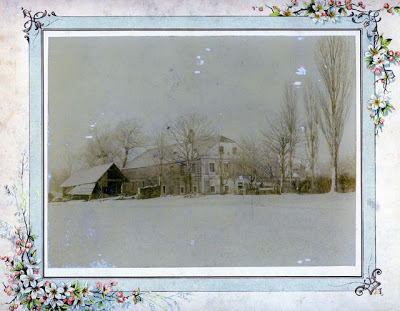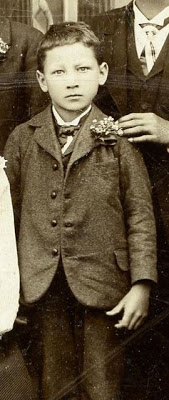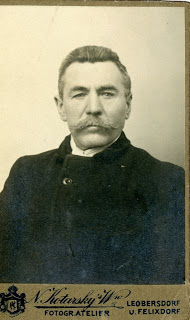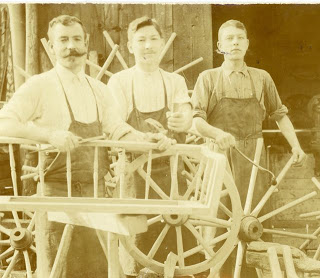
Theresia and Paul Müller, parents to Therese Woschkeruscha, maternal grandparents to Luise Woschkeruscha
Last week, we learned that Lil’s mother, Louise, was sinking into mental illness just before Lil and Fred’s wedding. (See More than I could stand.)
While the origins of Louise’s mental illness can’t be pinpointed, some facts about her childhood may throw some light the possible origins of her incendiary temper.
Aloisia (in America, Louise) Woschkeruscha’s mother was Therese Müller, daughter of a successful miller and farmer, Paul Müller and his wife, Theresia, nee Blaschka. (Couple at left).
Paul owned 80 “yokes” of land, the amount of land two oxen, yoked together, could plow in a day, and a flour mill on the Mank River, not far from Vienna, Austria. Neighbors could never figure out how Paul Müller came up with the most creative and innovative approaches to both the skill and business of milling and farming. They didn’t know that he sat up late into the night reading a publication called Über Land und Meer (Over Land and Sea) learning the most up-to-date methods to keep ahead of the curve. At a time when many of his peers couldn’t even read or write, it gave him a vital edge.
Paul and Theresia’s third child was named Therese, (photo left), mother to Aloisia and maternal grandmother to my mother, Lillian. Theresia, Therese’s mother, died in childbirth, but it’s not clear if she died giving birth to Therese or a later child. Paul remarried, but his second wife died in childbirth too. He then married a third time, to a woman, whom I believe was Anna, based on a funeral card we have in the collection. She was lucky enough to live to age 68.
As a young woman, Theresia met Johann Woschkeruscha, a handsome wagonmaker. Family lore has it that Johann seduced Therese Müller as a way to wheedle his way into her family money. My mother told me that the butcher in town begged Therese not to marry Johann. He, the butcher, loved her and didn’t care if she was pregnant with Johann’s child. It’s unclear to me if Therese loved Johann or just felt the child should be raised with her biological father. Whatever the reason for her decision, their differences in class and ethnicity infused their marriage and family life with tension and violence.

Paul Müller’s home, about 1900, location described on back: St. Leonhardt am Forst, bei St. Pelten, Nieder Österreich (lower Austria)

John Miller, about 8, nee
Woschkeruscha. Look at his
eyes and hand. I see a tense and angry little boy.
Johann apparently seethed over his inferior status. He would get drunk at a local bar and his fellow Bohemians would taunt him, “You let that German woman push you around? You should do something about her!” So he did. Drunk and embittered, he went home and beat his 4′ 11″ wife. He also beat Aloisia’s younger brother, whom I’ll call by his Americanized name, John, to keep him straight from his dad. John also trained as a wagon maker, like his father. I knew “Uncle John,” my mother’s uncle, here in America. Decades after leaving Austria, he could never speak of his father without shaking with rage, his face darkening, his voice quavering.
Family lore has it he ran away from home at the age of fifteen. Whether that age is correct, I’m not certain, but I do know, based on Ellis Island’s ship manifest, that John was twenty when he boarded the S.S. George Washington in Bremen on May 4, 1912, and arrived in New York on May 13th, destined for Chicago. He changed his name from Johann (Hans) Woschkeruscha to “John Miller,” using his maternal grandfather’s Americanized surname, to erase the familial connection to the man who had abused him.
I never heard that Johann, the father, beat Louise, but it’s pretty clear that she grew up in a home where violence was common and self-control in short supply. She, too, would develop a volatile temper.
Next week we’ll learn more about Louise’s childhood, her career as a dressmaker, and the disease that scarred her face and psyche.



Things haven’t changed much today;our son has a friend whose father beat him while in hs; those scars don’t go away and one wonders how they are passed on to the children. While I am better than when i was a teen, I still struggle to keep my mouth shut when anger overtakes me, knowing that hurtful words cannot be called back and are relived again and again.
i agree, Marian. Today we have “anger management” classes — so people can learn to curb their intense feelings. Then, everyone was on his/her own, and no inter-family abuse was considered none of anyone else’s business. So much for the “good old days.”
You do a great job telling this story. Yes, you can see that the 8-year-old John is not a happy child in that picture.
How the sins of the fathers (and mothers) live on. Very poignant entry.
I’m looking forward to learning more about Louise’s life. It seems that “dressmaker” was one of the few acceptable occupations for a woman of those times.
Linda, when you posted the story last week about Lil’s mother, I had wondered if it were more a case of post traumatic stress syndrome rather than what people commonly think of as mental illness. My godmother’s mother, herself an immigrant during war times, suffered such troubles in her older years and seemed to behave much the same as what you described last week. Now I see more of the story. Sad to think people go through such unfortunate relationships, but they do…sadder to see how these situations leave their indelible mark and shape us. It is the rare individual… Read more »
These stories are wonderfully moving and vivid, Linda. I so appreciate and enjoy reading them. And, do I ever admire your candor in sharing even the sad details. You’ve got a grand memoir here.